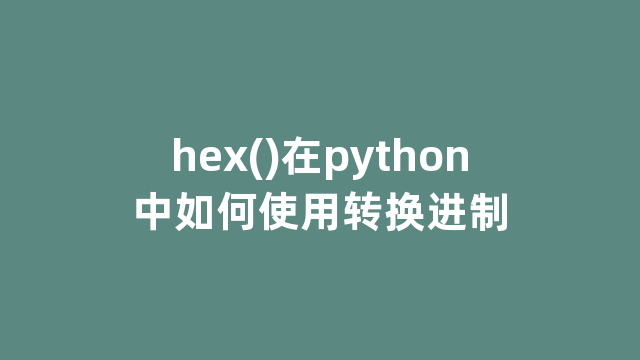
运算中的两种进制相信大家都不陌生,那就是十进制和十六进制。在操作中我们会根据不同的使用条件进行进制之间的转换。这里小编最近学习了一个内置函数,是专门针对进制转换使用的。下面我们先就hex()函数进行简单的概念理解,然后学习hex()在python中转换进制的方法。
一、说明:
1. 函数功能将10进制整数转换成16进制整数。
>>> hex(15) '0xf' >>> hex(16) '0x10'
2. 如果参数x不是整数,则它必须定义一个返回整数的__index__函数。
# 未定义__index__函数
>>> class Student:
def __init__(self,name,age):
self.name = name
self.age = age
>>>
>>> s = Student('Kim',10)
>>> hex(s)
Traceback (most recent call last):
File "<pyshell#17>", line 1, in <module>
hex(s)
TypeError: 'Student' object cannot be interpreted as an integer
# 定义__index__函数,但是返回字符串
>>> class Student:
def __init__(self,name,age):
self.name = name
self.age = age
def __index__(self):
return self.name
>>> s = Student('Kim',10)
>>> hex(s)
Traceback (most recent call last):
File "<pyshell#23>", line 1, in <module>
hex(s)
TypeError: __index__ returned non-int (type str)
# 定义__index__函数,并返回整数
>>> class Student:
def __init__(self,name,age):
self.name = name
self.age = age
def __index__(self):
return self.age
>>> s = Student('Kim',10)
>>> hex(s)
'0xa'
二、转为十六进制(Hex)字符串
def getStringFromNumber(self,size,value):
"""
转为十六进制(Hex)字符串
:param size:
:param value:
:return:
"""
size=int(size)
value=int(value)
by = bytearray([])
for i in range(1,size+1):
val = value >> 8 * (size - i) & 255
by.append(val)
val = by.hex()
print("===============================")
print("%s转为%s个字节十六进制(Hex)字符串:%s"%(value,size,val))
print("===============================")
return val
getStringFromNumber(5,11)
以上就是使用hex()在python中转换进制的方法,想要把十进制转换的小伙伴可以试试这种方法,更重要的是hex()会以字符串的形式展现出来。
神龙|纯净稳定代理IP免费测试>>>>>>>>天启|企业级代理IP免费测试>>>>>>>>IPIPGO|全球住宅代理IP免费测试





